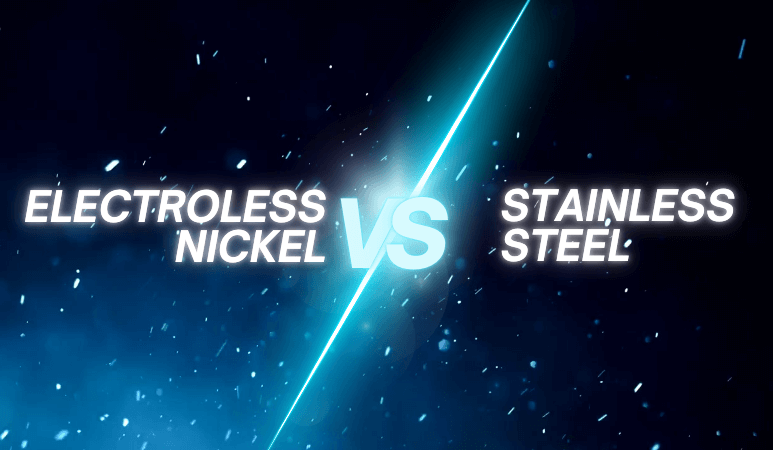When it comes to selecting the right material for industrial applications, understanding the properties of various options is crucial. Among the most debated choices are electroless nickel and stainless steel. These materials are widely used in industries ranging from automotive to food processing due to their excellent properties. But which one is the better choice for your needs? Let’s dive in and explore the key differences, advantages, and drawbacks of each.

[sc_fs_faq html=”true” headline=”h2″ img=”” question=”What is Electroless Nickel?” img_alt=”” css_class=””] Electroless nickel is a type of plating process that deposits a nickel-phosphorus or nickel-boron alloy onto a substrate. Unlike traditional electroplating, it does not require an electrical current. Instead, a chemical reduction process occurs in an aqueous solution, resulting in an even layer of nickel on various materials. [/sc_fs_faq]
Key Characteristics of Electroless Nickel:
- Uniform thickness regardless of geometry
- Excellent corrosion resistance
- Superior wear resistance
- Ability to coat non-conductive surfaces
What is Stainless Steel?
Stainless steel is a family of iron-based alloys containing at least 10.5% chromium, which gives it its unique corrosion-resistant properties. There are several types of stainless steel, each with distinct properties, but all share the core feature of resistance to rust and staining.
Key Characteristics of Stainless Steel:
- High resistance to corrosion and rust
- Strong and durable
- Good heat resistance
- Aesthetic appeal with a shiny finish
Electroless Nickel Plating Process
Electroless nickel plating involves a chemical bath that reduces nickel ions to form a metallic coating on a substrate. This process does not require electricity, making it more uniform and less likely to develop irregularities or weak points.
Advantages and Applications of Electroless Nickel Plating:
- Ideal for complex shapes and internal surfaces
- Often used in automotive and oil and gas industries
- Provides a hard, wear-resistant coating suitable for high-friction environments
Types of Stainless Steel
Stainless steel comes in various grades and compositions, each suited for different applications:
- Austenitic: The most common type, known for its excellent corrosion resistance and ductility.
- Ferritic: Less ductile than austenitic stainless steel but offers good corrosion resistance and is magnetic.
- Martensitic: Known for high strength and hardness but less corrosion resistance.
- Duplex: Combines the properties of austenitic and ferritic stainless steels, offering a balance of strength and corrosion resistance.
Comparison of Corrosion Resistance
When it comes to corrosion resistance, both electroless nickel and stainless steel have their merits.
- Electroless Nickel: Provides excellent resistance to a wide range of corrosive environments, including acidic and alkaline conditions.
- Stainless Steel: Typically offers high resistance to corrosion, particularly austenitic grades like 304 and 316, which are often used in marine and medical applications.
Wear Resistance Comparison
Wear resistance is crucial for materials exposed to friction and mechanical wear.
- Electroless Nickel: Known for its exceptional wear resistance due to its hardness, making it ideal for high-wear applications.
- Stainless Steel: Provides decent wear resistance, but it generally falls short compared to electroless nickel plating in high-friction environments.
Mechanical Properties
Understanding the mechanical properties of each material can help you make an informed choice:
- Electroless Nickel: Offers high hardness, which can be further enhanced through heat treatment, but is not very ductile.
- Stainless Steel: Offers a good balance of strength, ductility, and toughness, making it more versatile for various applications.
Thermal Conductivity and Heat Resistance
Thermal properties can affect performance in high-temperature environments:
- Electroless Nickel: Generally offers moderate thermal conductivity and resistance, which can vary based on the phosphorus content.
- Stainless Steel: Provides better heat resistance, especially in austenitic grades, making it suitable for high-temperature applications like kitchen equipment and industrial furnaces.
Aesthetic Considerations
The appearance of the materials can also be a deciding factor:
- Electroless Nickel: Has a smooth, matte finish that is less reflective but looks uniform and professional.
- Stainless Steel: Offers a shiny, polished appearance that is aesthetically pleasing, especially in consumer-facing applications.
Cost Analysis
Cost is often a significant factor in material selection:
- Electroless Nickel Plating: The cost can vary based on the plating thickness and material, but it is generally considered more cost-effective for smaller parts.
- Stainless Steel: Usually more expensive upfront due to its alloying elements, but it offers lower maintenance costs in the long run.
Applications and Industries
Both materials find their place in various industries:
- Electroless Nickel: Used in automotive, electronics, aerospace, and oil and gas for its wear and corrosion resistance.
- Stainless Steel: Common in construction, medical devices, kitchen equipment, and food processing industries due to its hygienic properties.
Advantages and Disadvantages of Electroless Nickel
Pros:
- Uniform coating
- Excellent wear and corrosion resistance
- Can coat non-conductive surfaces
Cons:
- Not as ductile as stainless steel
- Limited heat resistance
Advantages and Disadvantages of Stainless Steel
Pros:
- High corrosion resistance
- Strong and durable
- Versatile across industries
Cons:
- More expensive
- Requires careful selection of grades for specific applications
| Read More Topics |
| What is edge bleed for moisture barrier? |
| Is anodized aluminum or anodized steel cheaper |
| What is a microculture anthropology? |





